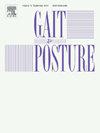Nonlinear analysis of the effects of vision and postural threat on upright stance
IF 2.2
3区 医学
Q3 NEUROSCIENCES
引用次数: 0
Abstract
Background
Humans maintain upright stance to interact with their surroundings. Linear analysis of these processes fails to address the nonstationary behavior of the human body, whereas dynamical nonlinear approaches consider the underlying dynamics of postural sway. Here, behavior during upright stance was examined using nonlinear methods to provide additional insights into the effects of postural threat (height above ground) and vision on postural control.
Research question
Can nonlinear methods provide more comprehensive identification and analysis of height- and vision-related changes in quiet standing?
Methods
This study is a secondary analysis of a previously collected and published dataset. Twenty young healthy adults performed a 60 s quiet standing balance task under all combinations of: (1) two height conditions: standing at ground level (LOW) and standing 3.2 m above ground level (HIGH); and (2) two visual conditions: eyes open (EO) and eyes closed (EC). Recurrence quantification analyses (RQA) were performed on centre of pressure (COP) and centre of mass (COM) data to calculate Recurrence Rate (%REC), Determinism (%DET), Entropy (ENT), and Average Line Length (LINE).
Results
For COP, %DET, ENT, and LINE showed significant effects of vision and height, with the values of each measure being lowest in the HIGH-EC condition. For COM, %DET, ENT, and LINE showed significant effects for vision, with the values of each being lower in the EC compared to EO condition; additionally, %DET was significantly smaller in the HIGH condition compared to LOW.
Significance
RQA identified differences in sway dynamics across both vision and height conditions that linear methods failed to detect. They represented greater randomness and adaptability in response to increased fear (HIGH) or decreased sensory information (EC). The novel effects observed with these RQA variables suggest nonlinear analyses provide a more robust tool for identifying the effects of postural threat and vision on upright stance.
视觉和姿势威胁对直立姿态影响的非线性分析
人类保持直立姿势与周围环境互动。这些过程的线性分析无法解决人体的非平稳行为,而动态非线性方法考虑了姿势摇摆的潜在动力学。本研究使用非线性方法研究直立站立时的行为,以进一步了解姿势威胁(离地高度)和视觉对姿势控制的影响。研究问题:非线性方法能否对安静站立时的高度和视觉相关变化提供更全面的识别和分析?方法本研究是对先前收集和发表的数据集进行二次分析。20名年轻健康成人在以下两种高度条件下进行60 s安静站立平衡任务:(1)站在地面(LOW)和站在离地面3.2 m (HIGH);(2)两种视觉状态:睁眼(EO)和闭眼(EC)。对压力中心(COP)和质心(COM)数据进行复发量化分析(RQA),计算复发率(%REC)、确定性(%DET)、熵(ENT)和平均线长(Line)。结果COP、%DET、ENT和LINE对视力和身高有显著影响,且在高ec条件下各项指标均最低。对于COM, %DET, ENT和LINE对视力有显著影响,EC条件下的值比EO条件下的值低;此外,在高条件下,%DET明显小于低条件。显著性qa确定了在视觉和高度条件下,线性方法无法检测到的摇摆动力学差异。当恐惧增加(HIGH)或感觉信息减少(EC)时,它们表现出更大的随机性和适应性。通过这些RQA变量观察到的新效应表明,非线性分析为识别姿势威胁和视觉对直立姿态的影响提供了更强大的工具。
本文章由计算机程序翻译,如有差异,请以英文原文为准。
求助全文
约1分钟内获得全文
求助全文
来源期刊

Gait & posture
医学-神经科学
CiteScore
4.70
自引率
12.50%
发文量
616
审稿时长
6 months
期刊介绍:
Gait & Posture is a vehicle for the publication of up-to-date basic and clinical research on all aspects of locomotion and balance.
The topics covered include: Techniques for the measurement of gait and posture, and the standardization of results presentation; Studies of normal and pathological gait; Treatment of gait and postural abnormalities; Biomechanical and theoretical approaches to gait and posture; Mathematical models of joint and muscle mechanics; Neurological and musculoskeletal function in gait and posture; The evolution of upright posture and bipedal locomotion; Adaptations of carrying loads, walking on uneven surfaces, climbing stairs etc; spinal biomechanics only if they are directly related to gait and/or posture and are of general interest to our readers; The effect of aging and development on gait and posture; Psychological and cultural aspects of gait; Patient education.
 求助内容:
求助内容: 应助结果提醒方式:
应助结果提醒方式:


